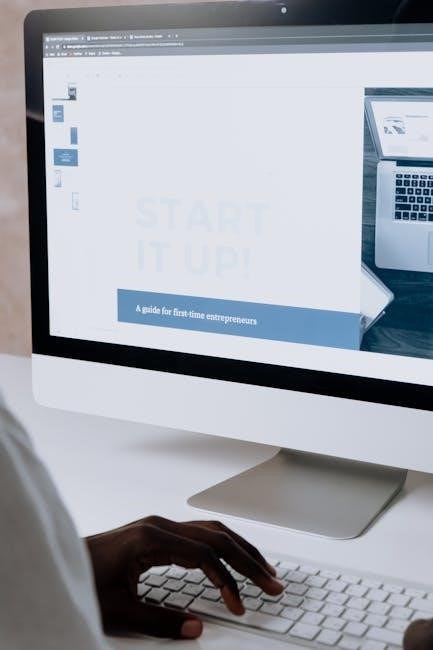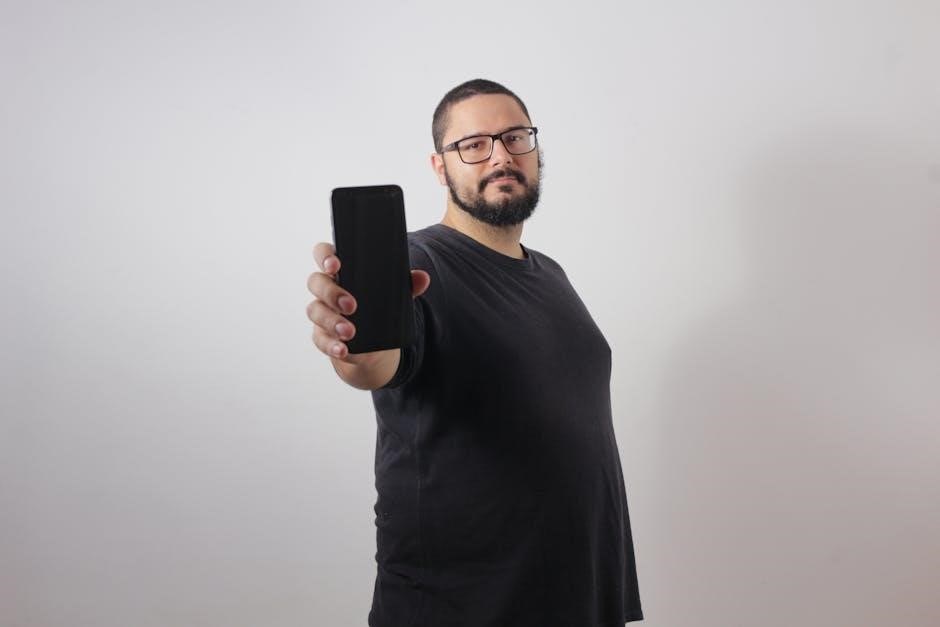Welcome to the Contour Next One User Guide, your comprehensive resource for mastering the blood glucose monitoring system․ This guide provides detailed instructions for setup, usage, and troubleshooting, ensuring optimal performance and accurate results for effective diabetes management․
1․1 Overview of the Contour Next One Blood Glucose Monitoring System
The Contour Next One is a user-friendly blood glucose monitoring system designed for easy and accurate blood sugar testing․ It features No Coding technology, automatic control solution testing, and Bluetooth connectivity for seamless data transfer to the Contour Diabetes App․ The system is built for simplicity, providing clear instructions and instant results, making it an essential tool for effective diabetes management․ Its intuitive design ensures a smooth testing experience for users of all skill levels․
1․2 Importance of Reading the User Guide
Reading the Contour Next One User Guide is essential to ensure accurate blood glucose testing and proper device handling․ It provides step-by-step instructions for setup, usage, and troubleshooting, helping users avoid errors and incorrect results․ The guide also outlines safety precautions, maintenance tips, and warranty information, ensuring users get the most out of their meter while maintaining their health and safety․ Following the guide guarantees optimal performance and reliable results for effective diabetes management․

Setting Up Your Contour Next One Meter
Setting up your Contour Next One Meter is straightforward, ensuring ease of use and accurate results․ Follow the guide for a seamless experience with essential materials prepared․
2․1 Unboxing and Initial Setup
Upon unboxing your Contour Next One Meter, ensure all components are included: the meter, test strips, lancing device, lancets, and user guide․ Begin by inserting the battery or charging the meter if required․ Set the date and time to ensure accurate record-keeping․ Perform a control solution test to verify meter functionality․ Follow the user guide for step-by-step instructions to complete the initial setup successfully and prepare for your first blood glucose test․
2․2 Charging the Meter (if applicable)
Connect your Contour Next One Meter to a power source using the provided USB-C cable․ Ensure the meter is turned off during charging to avoid interruptions․ Charging typically takes 2-3 hours for a full battery․ The charging status indicator will show progress, turning off once fully charged․ Avoid using USB hubs, as they may reduce charging efficiency․ Always use the original cable to prevent damage․ A fully charged meter provides up to 1,000 tests․ Refer to the user guide for detailed charging instructions․
2․3 Setting the Date and Time
Accurately setting the date and time on your Contour Next One Meter is crucial for tracking your blood glucose results․ Navigate to the settings menu, select “Date and Time,” and use the arrow keys to adjust the values; Confirm your settings to save․ Ensure the time format (12/24-hour) matches your preference․ If synced with the Contour Diabetes App, the meter may automatically update․ For troubleshooting, refer to the user guide or contact support if issues persist․

Features and Benefits of the Contour Next One
The Contour Next One offers No Coding Technology for effortless testing, automatic control solution verification, and Bluetooth connectivity for seamless app integration, enhancing diabetes management convenience and accuracy․
3․1 No Coding Technology
The Contour Next One features No Coding Technology, eliminating the need for manual coding, which simplifies testing and reduces errors․ This technology automatically recognizes each test strip, ensuring accurate results without additional steps․ The system is designed for ease of use, making blood glucose monitoring faster and less complicated․ This feature is particularly beneficial for users who value convenience and reliability in managing their diabetes effectively․ It enhances the overall user experience by streamlining the testing process․
3․2 Automatic Control Solution Testing
The Contour Next One includes automatic control solution testing, ensuring meter accuracy and reliability․ This feature verifies the system’s performance by automatically detecting and processing control solutions, providing immediate feedback․ It eliminates manual calculations and reduces the risk of human error, giving users confidence in their results․ Regular control testing is essential for maintaining the integrity of blood glucose monitoring, and this feature makes it simple and efficient to perform these necessary checks․
3․3 Bluetooth Connectivity and App Integration
The Contour Next One features Bluetooth connectivity, enabling seamless data transfer to compatible smartphones via the Contour Diabetes App․ This integration allows users to track blood glucose levels, set reminders, and share results with healthcare providers․ The app offers detailed analytics and trends, supporting better diabetes management․ Remote monitoring and alerts enhance convenience, making it easier to stay on top of health metrics․ This connectivity ensures a connected and comprehensive approach to managing diabetes effectively․

Testing Your Blood Glucose
Testing your blood glucose with the Contour Next One is straightforward․ Prepare your meter, insert a test strip, and take a small blood sample․ The meter provides accurate results quickly, helping you monitor and manage your glucose levels effectively․
4․1 Preparing for a Test
Before testing, ensure your hands are clean and dry․ Gather the Contour Next One meter, test strips, lancing device, and lancets․ Check the meter’s battery level and ensure it is set up correctly․ Verify the expiration dates of test strips and lancets, and ensure all components are undamaged․ Familiarize yourself with the meter’s interface and settings․ Always refer to the user guide for specific preparation steps to ensure accurate and reliable results․ Proper preparation is key to successful blood glucose testing․
4․2 Inserting a Test Strip
To insert a test strip, hold it by the edges, ensuring not to touch the test area․ Align the strip with the meter’s strip port and gently push it in until it clicks․ The meter will automatically turn on and confirm the strip is inserted correctly․ Make sure the strip is not expired or damaged, as this could affect accuracy․ The Contour Next One’s No Coding technology eliminates the need for manual coding, simplifying the process for quick and reliable blood glucose testing․
4․3 Taking a Blood Sample
Wash and dry your hands before taking a blood sample․ Remove the endcap from the lancing device and loosen the lancet’s protective cap․ Choose a fingertip or alternate site, such as the palm or thigh․ Press the lancing device firmly against the skin until it triggers․ Gently squeeze the area to collect a small blood drop․ Avoid squeezing too hard to prevent inaccurate results․ The Contour Next One’s lancing device allows depth adjustment for comfort, ensuring a quick and virtually pain-free blood sampling experience;
4․4 Reading and Interpreting Results
The Contour Next One meter displays blood glucose results in just a few seconds․ The large, easy-to-read screen shows measurements in mg/dL or mmol/L, depending on your settings․ The meter features a color-coded target range indicator: green for within target, yellow for above, and red for below․ An audio beep confirms the reading is complete․ Use this data to monitor your glucose levels and adjust your diabetes management plan accordingly․ Always consult your healthcare provider for guidance on interpreting results․

Using Contour Next Test Strips
Proper handling and storage of Contour Next test strips ensure accurate results․ Always check expiry dates, avoid damaged strips, and use them correctly for reliable blood glucose readings․
5․1 Handling and Storing Test Strips
Always handle Contour Next test strips with care to ensure accuracy․ Store them in their original container, away from extreme temperatures and moisture․ Avoid exposing strips to direct sunlight or humid environments․ Handle strips gently to prevent bending or damage․ Keep them out of reach of children and pets․ Use strips within the expiry date printed on the container․ Proper storage and handling maintain the quality and reliability of your test results for accurate blood glucose monitoring․
5․2 Identifying Expiry Dates and Damaged Strips
Always check the expiry date printed on the test strip container before use․ Discard any expired strips, as they may provide inaccurate results․ Inspect each strip for visible damage, such as cracks, moisture exposure, or discoloration․ Do not use damaged or altered strips, as they can compromise test accuracy․ Properly dispose of expired or damaged strips to maintain the reliability of your blood glucose monitoring․ Ensure only intact, unexpired strips are used for testing․
5․3 Proper Disposal of Used Test Strips
Properly dispose of used test strips to ensure safety and environmental protection․ Place used strips in a puncture-resistant container, such as a sealed plastic bottle, to prevent accidental injury․ Do not recycle test strips, as they contain biological waste․ Check local regulations for specific disposal guidelines in your area․ Always follow these steps to prevent environmental contamination and maintain safety standards for handling medical waste․

Lancing Device and Lancets
The lancing device and lancets are essential for obtaining blood samples․ Proper assembly, depth adjustment, and safe handling ensure accurate results and minimize discomfort during testing․
6․1 Assembling the Lancing Device
Assembling the lancing device is a straightforward process․ Start by removing the endcap and loosening the round protective cap on a lancet․ Insert the lancet into the device, ensuring it clicks securely into place․ Replace the endcap and adjust the puncture depth setting as needed․ Always handle lancets with care to avoid injury․ Follow the user guide for detailed visual instructions to ensure proper assembly and safe operation of the lancing device․
6․2 Adjusting the Puncture Depth
To adjust the puncture depth on the lancing device, locate the endcap dial and rotate it clockwise to increase or counterclockwise to decrease the depth․ Choose a setting that balances comfort and blood sample size․ Start with a lower setting if you have sensitive skin․ Proper adjustment ensures a safe and effective blood sample collection․ Always follow the user guide for detailed instructions and refer to the visual aids provided to ensure correct technique and avoid injury․
6․3 Using and Storing Lancets Safely
Always handle lancets with care to ensure safety․ Remove the protective cap and use the lancet immediately, then discard it into a secure puncture-proof container․ Never reuse lancets, as this can lead to infection or inaccurate results․ Store lancets in a cool, dry place out of reach of children․ Proper disposal is essential to prevent accidental injury․ Refer to the user guide for detailed instructions on safe handling and storage to maintain hygiene and prevent potential hazards․

Understanding the Contour Diabetes App
The Contour Diabetes App is a user-friendly tool designed to help manage blood glucose tracking, offering insights and enhancing your diabetes management experience with ease and accuracy․
7․1 Downloading and Installing the App
To download the Contour Diabetes App, visit your smartphone’s app store․ Search for “Contour Diabetes App,” select it, and click “Download․” Once installed, open the app and follow the on-screen instructions to complete the setup․ Ensure your device is compatible with the app and that you have a stable internet connection for a smooth installation process․ This will allow you to seamlessly connect your Contour Next One meter and start managing your blood glucose data effectively․
7․2 Pairing the Meter with Your Smartphone
To pair your Contour Next One meter with your smartphone, open the Contour Diabetes App and ensure Bluetooth is enabled on your device․ Select the “Pair Device” option in the app and choose your meter from the available devices list․ Follow the on-screen instructions to complete the pairing process․ Once connected, your blood glucose data will automatically sync to the app, allowing for easy tracking and management of your diabetes․
7․3 Navigating the App Dashboard
The Contour Diabetes App dashboard is your central interface for managing blood glucose data․ It displays recent readings, trends, and insights․ Use the menu to access glucose tracking, reports, and settings․ Customize your view by selecting specific data ranges or filtering results․ The dashboard also provides quick access to app features like remote monitoring and data sharing․ Use the graphs and statistics to track progress and make informed decisions for effective diabetes management․

Remote Monitoring and Sharing Results
Remotely monitor blood glucose results and share data with caregivers or healthcare providers․ The app enables real-time access to your glucose trends, fostering collaborative diabetes management and timely support․
8․1 Setting Up Remote Care Partners
Setting up Remote Care Partners allows caregivers to monitor your glucose levels remotely․ Download the Contour Diabetes app, pair your meter via Bluetooth, and add partners through the app settings․ Ensure all parties have compatible devices and active internet connections․ This feature enhances support and enables timely interventions, promoting better diabetes management and peace of mind for both users and their care partners․
8․2 Sharing Data with Healthcare Providers
Sharing data with healthcare providers is seamless with the Contour Next One system․ Use the Bluetooth connectivity to sync results to the Contour Diabetes app, then export reports via email or SMS․ These reports include detailed logs, trends, and averages, providing clear insights for personalized care․ Regular sharing ensures healthcare providers can track your progress, offer tailored advice, and adjust treatment plans as needed, enhancing your diabetes management journey․
8․3 Receiving Alerts and Notifications
The Contour Next One system enables customizable alerts for high or low blood glucose levels, ensuring timely interventions․ Notifications are sent directly to your paired smartphone or device, providing real-time updates․ This feature enhances monitoring by alerting you or your remote care partners to critical changes, facilitating prompt action․ Customizable alerts can be set for specific glucose thresholds, offering added peace of mind and supporting proactive diabetes management․
Maintenance and Troubleshooting
Regular maintenance and troubleshooting ensure your Contour Next One meter performs optimally․ Clean the meter, resolve errors, and update software to extend its lifespan and reliability․
9․1 Cleaning the Meter
Regular cleaning ensures accurate performance and longevity of your Contour Next One meter․ Turn off the meter and wipe it with a soft, dry cloth․ Avoid harsh chemicals or moisture, as they may damage the device․ For stubborn marks, lightly dampen the cloth with water, but ensure the meter is dry before use․ Never submerge the meter in liquid․ Cleaning helps maintain hygiene and prevents contamination, ensuring reliable blood glucose readings․ Refer to the user guide for detailed cleaning instructions․
9․2 Resolving Common Errors
Identify and resolve common errors on your Contour Next One meter by checking the error messages․ For example, “E1” may indicate a test strip issue, while “LO” could mean a low battery․ Refer to the user guide for specific error codes and solutions․ Ensure test strips are valid, properly inserted, and not expired․ Restarting the meter or replacing the battery often resolves many issues․ If problems persist, contact Ascensia Diabetes Care support for assistance․ Regular maintenance helps minimize errors and ensures accurate readings․
9․4 Updating Meter Software
To update your Contour Next One meter software, connect it to the Contour Diabetes App via Bluetooth․ Ensure your smartphone has the latest app version installed․ Open the app, pair the meter, and follow on-screen instructions to check for updates․ If an update is available, download and install it․ Keep the meter connected until the update completes․ Avoid interrupting the process․ Once done, restart the meter to apply changes․ Regular updates ensure optimal performance and access to new features․

Safety Precautions and Warnings
Always handle the Contour Next One with care, avoiding extreme temperatures and moisture․ Use only authorized accessories and dispose of batteries and electronic components responsibly․ Follow all safety guidelines in the user guide to ensure safe operation and accurate results․
10․1 General Safety Guidelines
Always wash and dry your hands before handling the meter, test strips, or lancing device․ Avoid exposing the device to extreme temperatures, moisture, or direct sunlight․ Never use damaged or expired test strips, as this may lead to inaccurate results․ Keep the meter and accessories out of reach of children․ Follow all instructions carefully to ensure safe and effective use․ Properly dispose of used lancets and test strips to prevent injury or infection․
10․2 Handling Electrical Components
Handle electrical components with care to avoid damage․ Use only the provided charger and cable to prevent meter malfunction․ Keep the meter dry and avoid submerging it in water․ Do not modify or disassemble the device․ Store the meter in a cool, dry place when not in use․ Follow proper charging procedures to ensure longevity․ Avoid exposing the device to extreme temperatures or physical stress, which may damage internal components and affect performance․ Always check for visible damage before use․
10․3 Disposal of Battery and Electronic Components
Properly dispose of the battery and electronic components to minimize environmental impact․ Remove the battery before recycling or disposal․ Do not incinerate or crush the battery․ Check local regulations for hazardous waste disposal guidelines․ Recycle electronic components through authorized facilities․ Do not mix hazardous waste with household trash․ Ensure all components are handled by qualified professionals to comply with environmental standards․ Proper disposal helps protect the environment and public health․

Warranty and Manufacturer Information
The Contour Next One is manufactured by Ascensia Diabetes Care․ For warranty details, contact Ascensia Diabetes Care or visit their official website for comprehensive support information․
11․1 Understanding the Warranty Terms
The Contour Next One warranty covers manufacturing defects for a specified period, typically one year from the date of purchase․ It ensures the meter and accessories are free from defects in material and workmanship․ For detailed terms, contact Ascensia Diabetes Care or refer to the warranty document provided with your product․ Misuse or normal wear and tear are not covered under the warranty․ For inquiries or claims, reach out to their customer support team directly․
11․2 Contacting Ascensia Diabetes Care Support
For assistance with your Contour Next One meter, contact Ascensia Diabetes Care Support at 1-800-268-7200․ Visit their official website at ascensia․ca for support resources, troubleshooting guides, and product information․ Their office is located at 2680 Skymark Avenue, Suite 410, Mississauga, Ontario, L4W 5L6․ For general inquiries or warranty-related questions, use the contact form on their website or refer to the user guide for additional support options․
11․3 Finding Authorized Dealers and Distributors
To ensure authenticity and quality, purchase Contour Next One products from authorized dealers․ Visit the official Ascensia Diabetes Care website at ascensia․ca for a list of approved distributors․ You can also contact their customer support at 1-800-268-7200 for assistance in locating authorized sellers․ Always verify the legitimacy of dealers to avoid counterfeit products and ensure warranty validity․ Refer to the user guide for additional guidance on purchasing and product authenticity․
Conclusively, the Contour Next One offers ease of use and accuracy, featuring Bluetooth connectivity and no-coding technology․ Regular monitoring and proper maintenance ensure optimal performance for diabetes management․
12․1 Summary of Key Features and Benefits
The Contour Next One offers a user-friendly design with no-coding technology, eliminating the need for manual strip coding․ It features automatic control solution testing and Bluetooth connectivity for seamless data transfer to the Contour Diabetes app․ The meter provides accurate blood glucose readings, supports remote monitoring, and includes a lancing device with adjustable depth settings․ These features, combined with comprehensive app integration, make it an ideal choice for efficient and informed diabetes management․ Regular updates and a robust support system further enhance its functionality․
12․2 Encouragement for Regular Use and Maintenance
Regular use of the Contour Next One meter ensures accurate blood glucose monitoring and effective diabetes management․ Consistent maintenance, such as cleaning the meter and updating software, keeps the device functioning optimally․ By adhering to the user guide and app instructions, users can maximize the meter’s features, like Bluetooth connectivity and remote monitoring․ Proper care and routine checks prevent errors and extend the device’s lifespan, empowering users to take control of their health confidently․
